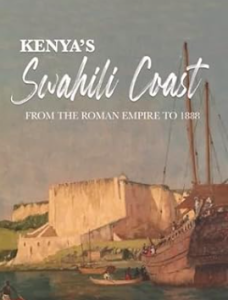
Kenya’s Swahili Coast – from the Roman Empire to 1888 by Judy Aldrick
We welcome this new title from historical writer Judy Aldrick. Aldrick has written widely on coastal history, art and architecture. She lived in Mombasa for 22 years where she found her passion for uncovering the history of the Swahili Coast. Aldrick says that she met many fascinating and warm hearted people there who welcomed her to their homes. She then realised that although the Swahili people were interested in their collective history, little was documented.
The culmination of over 40 years of research and study, Kenya’s Swahili Coast is a captivating journey into the heart of East Africa’s rich cultural tapestry, where history and tradition converge along the shores of the Indian Ocean. Aldrick’s meticulous research and evocative storytelling transport readers to a world of ancient Swahili cities and vibrant communities where, “in a brutal age, life was lived in the raw”.
It is based on many years of research in Old Town Mombasa, visiting sites along the coast, delving
into dusty archives in libraries and talking to and gathering information from local people…
This region, once a bustling hub of trade and cultural exchange, bears the indelible imprint of its diverse influences, from Arabic and Indian traders to African merchants and European explorers. Even in the era of the Roman empire, the coast was part of a well organised trade network. Further wealth and settlement came in the Islamic era, whereas the subsequent Portuguese colonisation brought a period of disruption, until Arabs from Oman revitalised the Coast. They also brought petty squabbles while ruling families and rival cities fought for power. Through periods of treachery and betrayal, as well as pragmatic diplomacy, the resilience and survival of the Swahili people shines through.

Author Judy Aldrick
With a keen eye for detail and a deep respect for the region’s diverse heritage, Aldrick traces the contours of Kenya’s coastal history, shedding light on the triumphs and tribulations of its people and the enduring legacy of its past. She tells of myth and magic, of unsolved mysteries, heroes and villains, alongside the facts and dates of history.
The book covers the coastal history up until 1888, when Coast and hinterland of East Africa become more integrated.
If you have ever been to the Swahili Coast, or are an armchair traveller, this book will put the region and its peoples into exciting historical and cultural contexts. Readers will gain a deeper understanding of the customs, traditions, history and artistic expressions that have shaped life along the Swahili Coast for centuries.
There will be a book launch celebrating Kenya’s Swahili Coast on Friday 26 April from 6:30pm at Under the Swahili Tree, Karen. RSVP required due to limited space: 0110509778


